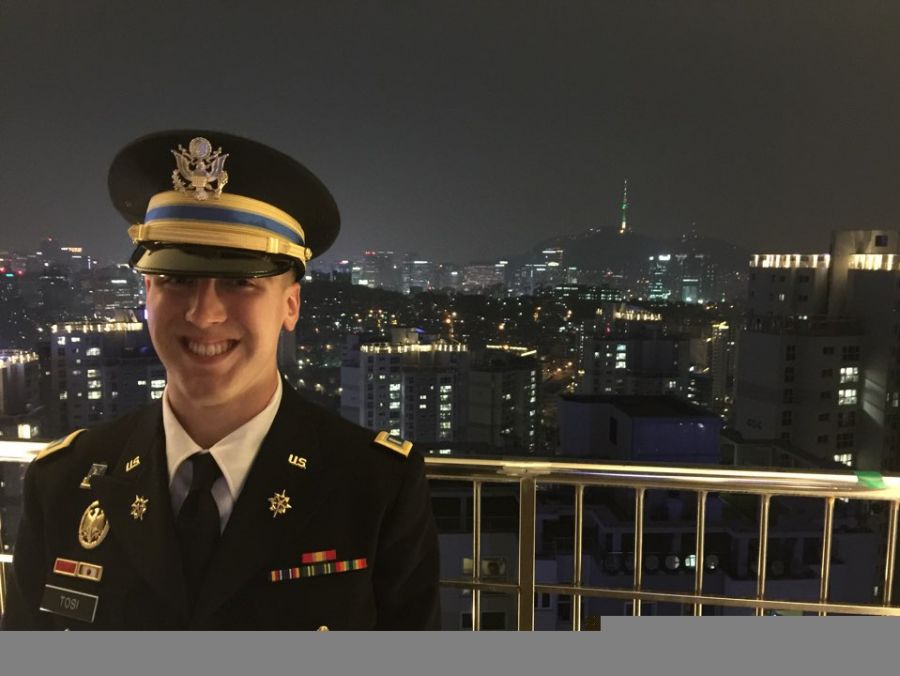The College of Applied Science and Technology’s “A Day in the Life of a CAST Alum” series is designed to shed some light on how CAST alumni spend their days. As with many careers, our alumni will tell you that every day is different, but this series aims to provide a peek into an alum’s world.
Scott Tosi ’14, serves as a military intelligence officer in the United States Army. His current position is the executive officer to headquarters and headquarters company for the 501st Military Intelligence Brigade in Seoul, South Korea. His responsibilities include maintaining accountability of the company’s property and intelligence collection assets spread across the Korean Peninsula, overseeing maintenance of all weapons systems, tactical, and nontactical vehicles, administration of over 160 U.S. and Korean soldiers, as well as direct command of 84 U.S. and Korean soldiers.
5 a.m.: Arrive at the office and check emails that came in from the United States overnight (Korea is 14 hours ahead of Central Standard Time). Send out last-minute emails for work that morning.
6:30 a.m.: Conduct physical readiness training with the company. This is basically an hour-and-a-half-long workout with the entire company. Today’s workout consisted of a 2-mile run in formation followed by a training circuit consisting of pushups, pull-ups, lunges, medicine ball sit-ups, kettle bell throws, and shuttle-sprints.
8 a.m.: Drive back to the office to shower and change from workout uniform to duty uniform. Have a sit-down with my commander to go over our agenda for the day and outlook for the upcoming week.
9:30 a.m.: Drive to the motor pool and oversee tactical vehicle maintenance (tactical vehicles are the typical army vehicles you see on TV). This consists of overseeing soldiers’ maintenance checks on vehicles, coordinating with the mechanics to ensure repair parts on order are still on schedule, checking to ensure all paperwork is filled out correctly by soldiers so parts and services will be conducted in a timely manner, and conducting a convoy of four vehicles out to the refueling point to ensure vehicles are running smoothly on the road. This week we also set up four DRASHs as a practical training exercise. These are basically large sturdy tents that can be compactly stored on the back of a trailer and are used for rapid-deployment of field stations.
12 p.m.: Release soldiers for lunch, drive back to the office, and eat lunch. Catch up on emails from the morning that I missed while I was at the motor pool. Compile all paperwork from maintenance, put it on personal tracking system, and send it in to maintenance shop for action.
1 p.m.: Conduct a meeting with key personnel for the upcoming machine gun and grenade launcher range I will be running.
1:30 p.m.: Conducted training meeting with the company commander and key personnel. Training meetings cover all upcoming training and time for lessons learned from training that was just conducted. The meeting consists of going over the long-range training calendar (four months out) to discuss general events, the six-week outlook to discuss more detailed plans of upcoming events, and the next week’s detailed training plan in which all members of the training talk about their part in the training and a walk-through is conducted. These meetings vary in length depending on the week, but this week’s meeting was a relatively short meeting, lasting only an hour.
2:30 p.m.: Check email and type up notes from the training meeting and send them out to personnel who could not be at the meeting.
3 p.m.: Conduct inspection of supplies for the chemical warfare training our company will be conducting tomorrow. This training consists of learning how to properly use gas masks and protective gear, culminating in soldiers going into a gas chamber and putting on their masks (the gas is essentially a vaporized form of pepper spray, so it only burns a little).
4 p.m.: Meet with senior Korean soldier to discuss issues with a couple of our Korean soldiers in the company. All Korean males have to serve two years in the military, with some being attached to the U.S. Army (called KATUSAs). This means that many Koreans have difficulty adjusting to the lifestyle and culture. Then follow up by talking to the two Korean soldiers to resolve the issue.
4:45 p.m.: Review all awards, passes, leaves, and other administrative actions sent in that day.
5 p.m.: Release soldiers to go home. Continue working on administrative actions.
6 p.m.: Sit down with commander to go over a status update on preparation for upcoming training and any last-minute changes that need to be made.
6:30 p.m.: Update slides for tomorrow’s weekly maintenance meeting. Since I will be in the field doing the chemical warfare training, I typed up a report explaining the slides in detail.
7:30 p.m.: Leave the office and drive home. With the way driving is in Korea, this is by far the most dangerous part of my day.
Got an idea for a future “Day in the Life” story? Contact us!

